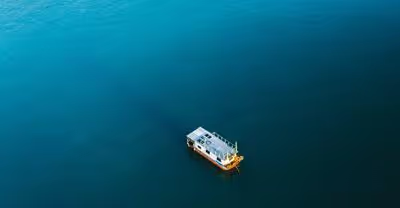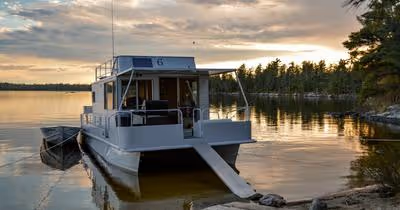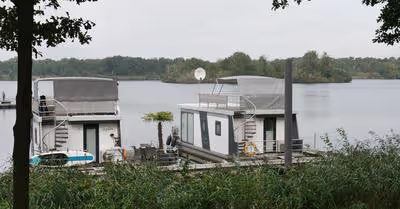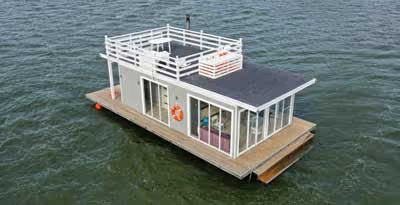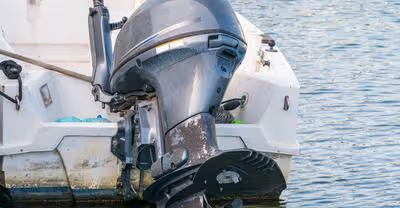
Key Takeaways
- Outdrive engines are a propulsion system that combines inboard and outboard motors.
- An outdrive motor is connected to an external steering component.
- Versatile in nature, outdrive engines can be used on a variety of boat types and sizes.
Master the art of outdrives with our concise and reader-supported article. Simplifying boat engine essentials for your sailing!
The outdrive on a boat engine is a crucial propulsion component mounted outside the hull. It combines the drive, propeller, and steering functions, powering your vessel efficiently through the water. Master its fall-safe mechanism for superior boating performance!
With years of hands-on experience backed by fellow boating pros, I've mastered the ins and outs of outdrives. Let's navigate the waves together as I share invaluable tips and insights for top-notch performance.
What Is The Outdrive On A Boat Engine?
One of the most important components of a boat is the propulsion system that drives it forward. There are various types of boat engines and drive systems available, but one that has gained significant popularity among boaters is the outdrive motor.
Outdrive engines, also known as the sterndrive system or inboard/outboard engines, combine the best qualities of inboard and outboard motors. This unique propulsion system consists of an engine mounted inside the boat's hull and a drive unit or steering component located outside the boat, submerged on its bottom half.
This powerful combination allows for smoother movement and better control while navigating through the water. Outdrive engines have become particularly popular due to their versatility, as they can be utilized on various boat types and sizes.
Understanding Boat Engines
Boat engines come in various shapes, sizes, and configurations, playing a crucial role in propelling and maneuvering watercraft.
Inboard Engine
An inboard engine is a type of motor that is mounted inside the boat's hull, typically under the stern. Often fueled by gasoline or diesel, these internal combustion engines transfer power through a direct drive shaft.
Let's look at the key features of inboard engines:
- Power Range: Inboard engines can range from small, single-cylinder motors to large, high-horsepower V8 engines in larger boats.
- Fuel Efficiency: Depending on the size and type of boat, inboard engines can provide better fuel efficiency compared to their outboard counterparts.
- Maneuverability: Inboard engines work in conjunction with a rudder to provide the steering, making them suitable for larger, heavier Jon boat metal parts.
- Maintenance: Due to their location within the hull, inboard engines may require more complex maintenance procedures.
- Application: Inboard engines are commonly used in larger vessels such as cruisers, yachts, and ski boats.
Some advantages of inboard engines include:
- Lower center of gravity for improved stability
- It can be easily upgraded for more power
- Quieter operation compared to outboard motors
Outboard Engine
An outboard engine is a self-contained propulsion system mounted on the stern of a boat, combining both the motor and drive unit. Outboard engines are popular for their versatility and ease of use, suitable for a wide range of smaller boats.
Here's what you need to know about outboard engines:
- Power Range: Outboard engines range from small, portable 2-horsepower many models to powerful V6 engines with over 300 horsepower.
- Fuel Efficiency: Modern outboard engines, particularly 4-stroke models, are increasingly fuel-efficient and environmentally friendly.
- Maneuverability: Outboard engines can be steered directly for precise control and can be tilted out of the water when not in use to prevent corrosion and fouling.
- Maintenance: Outboard motors are generally easier to access and maintain compared to inboard engines.
- Application: Outboard engines are ideal for smaller boats like fishing boats, inflatables, and runabouts.
Here are a few advantages of outboard engines:
- Removable and easily replaceable
- It can be operated in shallow waters
- Lighter weight compared to inboard engines
Hybrid Option: Stern-drive Engine
A sterndrive engine, also known as an inboard/outboard engine, combines elements of both inboard and outboard motors. The engine is mounted inside the boat under the stern, while the drive unit is submerged in the boat's bottom half, unlike the upper half.
In the below table, we've summarized some key features of common boat engines:
What is an Outdrive?
An outdrive, also known as a sterndrive, is a marine propulsion system combining the features of both inboard and outboard engines. It allows boats to achieve efficient and robust movement through the water. Found in a variety of boats, outdrives provide optimal control and maneuverability.
Components of an Outdrive
- Propeller: The propellers are key components in an outdrive component, providing thrust to propel the boat through the water.
- Hull: The boat's hull houses the inboard engine, which is connected to the outdrive unit.
- Transom: The outdrive attaches to the boat's transom, which is the flat section on the stern of the vessel.
- Shaft: The drive shaft connects the inboard engine to the outdrive unit and transfers enough power from the engine to the propeller.
- Drive Unit: The external drive unit houses the propeller and steering components and is responsible for directing the boat's movement.
- Rudder: The rudder is a pivotal device that helps steer the boat when the outdrive is in motion.
- Gearbox: The gearbox helps transmit power from the engine to the propeller, enabling boat propulsion.
- Lower Unit: The lower unit houses the gear rotation and components that allow the propeller to rotate and generate thrust.
Here's a table with the components of a boat and their description
Types of Outdrives
- Sterndrives: The most common type of outdrive, sterndrives consist of an inboard engine connected to an outdrive unit mounted on the boat's stern. These versatile systems offer excellent maneuverability and performance for a variety of boats.
- Surface Drives: Surface drives are outdrive systems designed for high-speed boats with their propellers partially submerged. This setup minimizes drag and maximizes speed but sacrifices some control and maneuverability.
- Pod Drives: These modern outdrive systems integrate the engine, transmission, and steering into a single unit, simplifying installation and maintenance. Pod drives provide excellent maneuverability, making them popular in larger vessels like cruisers and yachts.
Here's a table with types of boat out-drive examples and their descriptions
Outdrive vs. Other Drive Systems
Outdrive boat engines are not the only option out there for boaters. Let's compare outdrive systems with other popular boat drive systems, such as jet drives, inboard/outboard (I/O) drives, and stern drives.
Jet Drive
A jet drive is an innovative propulsion system that uses a high-pressure stream of water to propel the boat.
This system is especially popular in personal watercraft due to its lightweight design and high efficiency.
- Advantages: Jet drives are known for their shallow draft capabilities, allowing a boat to maneuver in shallow water without damaging the propulsion system. This feature makes them ideal for water-repelling flaps, sports, and exploring tight areas.
- Disadvantages: Jet drives tend to be less fuel-efficient compared to other drive systems, especially at lower speeds. Furthermore, their acceleration and top speeds might not be suitable for larger vessels.
Inboard/Outboard (I/O) Drive
An I/O drive is a hybrid of inboard and outboard motor systems, with an engine mounted inside the boat and a propeller outside the hull. This type of drive system is common in smaller boats and yachts.
- Advantages: I/O drives offer a good blend of power, maneuverability, and fuel efficiency, making them versatile for various boat types. Counter-rotating propellers can help increase boat stability and improve overall performance.
- Disadvantages: I/O systems can be complex, resulting in more maintenance and potential repair costs compared to simplistic systems like outboards. Additionally, they might not work well in saltwater environments, causing corrosion issues.
Stern Drive
Stern drives, also referred to as sterndrives, are similar to I/O drives but with the engine mounted lower in the hull, closer to the propeller. This setup provides better balance and increased boat performance.
- Advantages: Thanks to their lower profile, stern drives offer enhanced handling, making them a popular choice for watersports enthusiasts. They are also better suited for larger vessels, providing adequate power and improved fuel consumption.
- Disadvantages: Stern drives can be expensive to maintain, and their lower mounting position makes them more susceptible to damage, especially in shallow waters. Like I/O drives, stern drives may also experience complications in saltwater conditions.
Here's a table showing the advantages and disadvantages of boat drive systems
Outdrive Brands and Market Share
When it comes to boat engine outdrives, the market is dominated by two major players: Volvo Penta and MerCruiser. These brands offer a variety of sterndrive systems that cater to boaters in the USA and across the globe.
Volvo Penta and MerCruiser have been at the forefront of sterndrive technology for decades. They are known for their reliable and innovative aqua-matic systems that deliver the power and performance required by both recreational and professional boaters.
Here is a brief overview of these two major outdrive brands:
Volvo Penta
- A Swedish company, part of the Volvo Group, that has been manufacturing marine engines since 1907
- Known for their powerful, fuel-efficient, and environmentally friendly engines
- Offers a range of gasoline and diesel sterndrive engines, perfect for both small runabouts and larger cruising boats
- Introduced the first Aquamatic outdrive system in 1959, which revolutionized the boating industry
MerCruiser
- A division of the Outboard Marine Corporation and now owned by Mercury Marine
- One of the leading sterndrive manufacturers, with a market share estimated to be over 80% at its peak in the '70s, '80s, and '90s
- Offers a wide range of sterndrive engines, including both gasoline and diesel options
- Known for their reliability and efficient performance
While exact market share figures are hard to come by, it is clear that both Volvo Penta and MerCruiser have a significant presence in the sterndrive market. According to Boating Industry, sterndrive sales have declined in recent years, with more boaters opting for outboard engines.
However, these two brands continue to innovate and provide top-quality sterndrive solutions for various boating applications.
In addition to these major players, there are other smaller brands offering sterndrive systems. Some of these include:
- OMC (Outboard Marine Corporation) - An American manufacturer that was once a major player in the industry but filed for bankruptcy in 2000
- Yanmar - A Japanese company known for its diesel engines and marine drive systems, including sterndrives
Here's a quick comparison of Volvo Penta and MerCruiser in terms of their key sterndrive offerings:
Outdrive Performance and Efficiency
Outdrive engines, also known as inboard/outboard or sterndrive engines, offer a unique combination of inboard engine power and outboard motor mounted maneuverability.
Maneuverability
One of the key advantages of outdrive engines is their ability to provide a high level of maneuverability during navigating difficult waters or in tight docking situations.
Since the propeller and the outdrive itself can be steered independently from the main inboard engine, you gain a greater degree of control when compared to traditional inboard systems.
- In addition to a traditional steering wheel setup, outdrive systems typically offer improved low-speed maneuvering capabilities.
- Anglers in fishing boats and many boat owners benefit from the ability to make quick turns or reverse directions without losing speed.
- Bowriders and pontoon boats, popular for family outings, gain a user-friendly advantage when it comes to docking or navigating crowded marinas.
Power-to-Weight Ratio
The power-to-weight ratio of an outdrive engine directly impacts its overall efficiency and performance.
The ratio balances two key components:
- Engine Power: The engine's ability to generate torque and move the boat forward or backward, and
- Boat Weight: The overall mass of the boat (including passengers and gear).
An optimal power-to-weight ratio delivers efficient acceleration, better fuel efficiency, and a smoother overall ride.
Outdrive engines typically have a four-stroke automotive engine housed inside the boat's hull, which offers a higher power-to-weight ratio compared to purely outboard unit systems.
This directly benefits:
- Fishing boats: Achieving better trolling speeds and fuel efficiency.
- Pontoon boats: Offering smoother and more stable acceleration.
- Watersports enthusiasts: Providing powerful performance for towing or acceleration.




